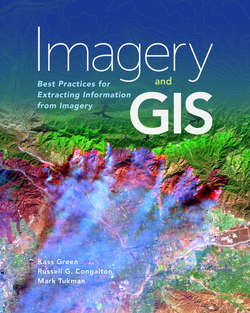Читать книгу Imagery and GIS - Kass Green - Страница 54
На сайте Литреса книга снята с продажи.
Extent
ОглавлениеThe term extent is used to refer to the area on the ground that can be captured with each exposure of the sensor. It is often used relative to one mission or collection and is determined by the sensor size, its focal length, and its distance to ground. Many satellite systems collect imagery continually along their orbital paths. The area collected is, therefore, constrained by the width of the sensor’s swath, but not by the strip length. The length of individual satellite scenes is arbitrary and is determined by the operator of the system. Most scenes are approximately square. For example, a Landsat scene is 170 by 183 kilometers.
The size and shape of a project area will affect what remote sensing systems are most suitable for imaging it. Because of their altitude, satellites can capture large areas in individual satellite scenes (e.g., a Landsat scene covers just over 12,000 square miles). However, satellite images are restricted to the satellite’s orbital paths, making aircraft systems more effective in collecting linear or sinewy project areas (such as riparian areas, transmission lines, and coastlines) because aircraft are not tied to an orbit.
Helicopters are ideally suited to collect data over multiple distributed points because they are more agile than airplanes. They are also suitable for collecting data along corridors where frequent turning may be necessary. Fixed-wing aircraft are more suitable for collecting imagery over large areas because they can quickly collect large swaths of data. For extremely large areas, a high-altitude aircraft or satellites might be employed to maximize ground coverage.
For example, a riparian mapping project, following a long sinewy river with a required spatial resolution of 1 meter will probably be better accomplished with an airborne system than with a satellite system. The airborne platform can follow the path of the river and constrain its data collection to only the river area. Using data from a satellite system would require collecting multiple scenes, and then extracting the river areas from the larger scenes. More area and thus more data than required would be collected, which would increase the cost of the project.
An advantage that moderate-spatial-resolution, large extent satellite systems (e.g., Landsat and Sentinel) have over airborne collections is that the entire scene is captured at once with instantaneous sun illumination, vegetative condition, and atmospheric conditions fixed across the scene. Capturing the same area as a Landsat scene with an aircraft system would take several days, with the sun illumination, vegetation, and weather conditions changing throughout each day and from day to day. These variations can introduce confusion when the images are manually interpreted or classified to create maps.
High-spatial-resolution systems (both airborne and satellite) have a smaller extent than moderate- and low-spatial-resolution systems, but individual scenes can be mosaicked together to represent a larger area. Mosaicking is discussed in more detail in chapter 5.
